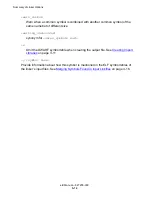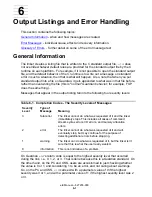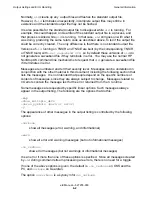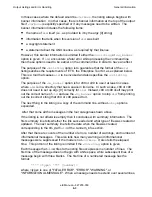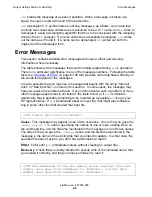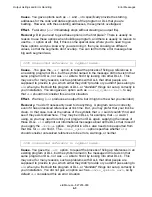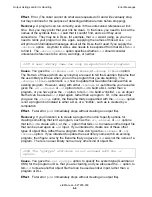
Output Listings and Error Handling
eld Manual—527255-009
6-8
Error Messages
link,
eld
looked at some other DLL whose addresses didn’t fit into 32 bits. In either
case, the program or DLL that you are trying to build contains 32-bit pointers that need
to be initialized with the addresses of symbols, in the file being built or in some other
DLL, whose addresses can’t be represented in 32 bits.
Effect.
Error (The linker cannot do what was requested of it and will eventually stop,
but may continue for the purpose of detecting additional errors before stopping).
Recovery.
Did you need to use the
-t
and
-d
options? There usually is no reason to
use these options when building a program, and there usually is no reason to use the
-
d
option at all. But, if you want to assign addresses to this program or DLL that don’t fit
into 32 bits, or make references to some other DLL that has a range of addresses that
doesn’t fit into 32 bits, then change your source code so that it doesn’t try to use 32-bit
pointers in those cases.
Cause.
You gave options such as the
-t
and
-d
options to specify the starting virtual
addresses for the code and data segments of the program or DLL that you are
creating, and you specified addresses that wouldn’t fit into 32 bits. Or, as part of this
link,
eld
looked at some other DLL whose addresses didn’t fit into 32 bits. In either
case, the program or DLL that you are trying to build contains 32-bit pointers that need
to be initialized with the addresses of symbols, in the file being built or in some other
DLL, whose addresses can’t be represented in 32 bits, or at least not when the offset
mentioned in the message is added to their addresses.
Effect.
Error (The linker cannot do what was requested of it and will eventually stop,
but may continue for the purpose of detecting additional errors before stopping).
Recovery.
Did you need to use the
-t
and
-d
options? There usually is no reason to
use these options when building a program, and there usually is no reason to use the
-
d
option at all. But, if you want to assign addresses to this program or DLL that don’t fit
into 32 bits, or make references to some other DLL that has a range of addresses that
doesn’t fit into 32 bits, then change your source code so that it doesn’t try to use 32-bit
pointers in those cases.
Cause.
You gave options such as the
-t
and
-d
options to specify the starting virtual
addresses for the code and data segments of the program or DLL that you are
creating, and you specified addresses that wouldn’t fit into 32 bits. Or, as part of this
link,
eld
looked at some other DLL whose addresses didn’t fit into 32 bits. In either
case, the program or DLL that you are trying to build contains 32-bit procedure pointers
1012 Input file <filename> specifies that the address of
<symbol name>, plus <number>, is supposed to be placed into a
32-bit pointer, but it doesn't fit into 32 bits.
1013 Input file <filename> specifies that the address of
<symbol name> is supposed to be placed into a 32-bit
procedure pointer, but it doesn't fit into 32 bits.
Summary of Contents for eld
Page 4: ......
Page 8: ...Contents eld Manual 527255 009 iv ...
Page 12: ...What s New in This Manual eld Manual 527255 009 viii Changes to the 527255 005 Manual ...
Page 34: ...Introduction to eld eld Manual 527255 009 1 14 Example of Use ...
Page 54: ...eld Input and Output eld Manual 527255 009 2 20 Using Archives ...
Page 98: ...Other eld Processing eld Manual 527255 009 4 20 Merging Source RTDUs ...
Page 242: ...Output Listings and Error Handling eld Manual 527255 009 6 132 Glossary of Errors ...







